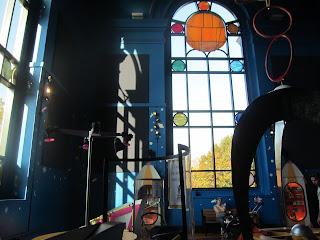(photo from www.myphillyalive.com)
Space Station exhibit in Flight Fantasy
This week's visit
to the Please Touch Museum was a lot
of fun and I am still impressed by the larger than life set and exhibit design
that was put in to this beautiful building. I remember going to the Please Touch Museum as a child with my
younger brother, and thinking it was fun but enjoying the Franklin Institute more because it felt bigger and more exciting to
me and at the time the Franklin was
more age appropriate for me. I feel like if I had experienced this Please Touch Museum as a child, the colorful
murals and large trees and cloud installations and the ability to feel as
though you are always stepping into a new place every time you change areas
would have captivated me. It is a really exciting environment to be in. As an
adult, learning about the history and architecture of Memorial Hall is also
fascinating to me. I recently did a research paper on the Please Touch Museum's collections and how it meets its audiences. I
find the museum does a great job of creating their exhibits to be for children
7 and under, their target audience they defined, and also providing tours and
the Centennial Exhibit for the accompanying adults who want to know more about
the history. During my visit in the summer, myself and the adults I was with
wanted to know more about the building and the little things around the museum,
such as plaques on the wall in the main lobby telling you that it’s painted in
period colors, and the more text rich Centennial Exhibit answered our need to
know more about the building.
 |
| Variables available for rocket launching |
That aside, my
favorite area in the museum is the Flight
Fantasy play area. I think it’s the scientist in me because the area's interactives
are based on STEM (science, technology, engineering, and math)
activities. The futuristic blue and neon colors are so bright and
transport you to space. A lot of the exhibits provide a lot of different
variables to try and manipulate to learn from. My favorite “object” or interactive
is the rocket building activity in the Space
Station room. The exhibit is based on building a rocket and launching it
using air cannon. Children can choose different shapes and sizes to experiment
with to see what flies the best. Again, I appreciate the use of variables to
encourage inquiry based learning. The interactive is futuristic looking
and is designed to look like a space launch pad and the center piece looks like
a giant rocket.
 |
| Solar System stained glass- want!! |
The Flight Fantasy Area is the newest play
area at the Please Touch Museum and
was opened in October 2010.
The rocket building interactive can lead to children wanting to
explore fields in engineering and astronomy to enrich their exploration. The
entire space can help create an interest in science and technology in both
young and old audiences. For me personally to understand the object better,
either a greater background in rocket engineering and projectile motion or a
greater knowledge of early childhood fine motor skills development and how they
interpret STEM concepts and what the lasting impression of this interactive has
on them.
Those who would
not be interested in this object could be those with little interest in space
and children with a brief attention span who don't first get the idea of trying
lots of variations of rockets, unless a parent encourages it, or parents who
also don't try the variables and believe it’s a once and done activity.
Opposing views would believe that it is meant to be just a try it once and move
on and miss the concept of exploration with all the different sized rockets and
shapes.
Other experiences
that would engage the visitor could be stomp rockets or catapults to learn
about projectile motion. Stomp rockets are a great activity to be made at home
and can be done with children of all ages including high school students and
kindergartners.






